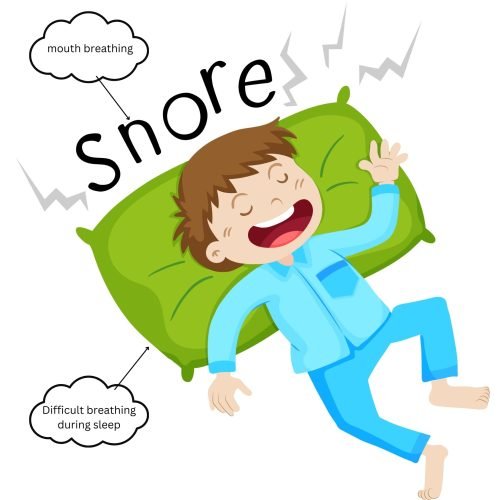Obstructive Sleep Apnea
Obstructive Sleep Apnea
Obstructive sleep apnea (OSA) occurs when a child’s airway becomes partially or completely blocked during sleep. This blockage causes brief interruptions in breathing, typically lasting a few seconds, before the brain wakes the child up to resume breathing. These pauses in breathing can happen multiple times throughout the night, leading to poor quality sleep, decreased oxygen levels, and if untreated, long-term health issues.

Causes of OSA in children:
- Enlarged tonsils and adenoids
- Obesity
- Facial and jaw abnormalities from birth
- Certain genetic syndromes: e.g. Prader-Willi syndrome, Down syndrome
Common symptoms of OSA in children
Night-time Symptoms:
- Loud, frequent snoring , which may be interrupted by periods of silence (when breathing stops), followed by a gasp or snort as the child resumes breathing.
- Child may seem to stop breathing or hold breath during sleep. These pauses often last for several seconds.
- Mouth breathing especially during sleep
- Children with OSA often toss and turn during sleep, and may appear restless or uncomfortable.
- Excessive sweating during sleep or frequent waking throughout the night may indicate disrupted sleep patterns due to OSA.
Daytime Symptoms:
- Excessive daytime sleepiness
- Behavioral issues such as irritability, mood swings, hyperactivity, or difficulty concentrating. This may sometimes be misdiagnosed as ADHD (Attention Deficit Hyperactivity Disorder).
- Poor growth and development: Chronic sleep deprivation can hinder a child’s growth, both physically and cognitively. A child may be slow to develop motor skills or may show delays in speech or language development.
- Frequent morning headaches: Low oxygen levels caused by obstructed breathing during the night can trigger headaches upon waking.
Diagnosis of OSA
- Thorough medical history and examination
- X-ray soft tissue neck may be advised
- An overnight sleep study (polysomnography): This test involves monitoring the child’s brain waves, heart rate, oxygen levels, and breathing patterns during sleep. In some cases, a home sleep apnea test may be recommended.
Treatment options for OSA
The treatment approach depends on the severity of obstruction, its underlying causes, and child’s age. Treatment options include:
Tonsillectomy and Adenoidectomy
For many children with enlarged tonsils and adenoids, the most effective treatment is the surgical removal of these structures.
Continuous Positive Airway Pressure (CPAP)
If surgery is not an option or if OSA persists after the removal of the tonsils and adenoids, your child may be prescribed a CPAP machine. This device delivers a continuous stream of air into the nose via a mask, keeping the airways open during sleep.
Bilevel Positive Airway Pressure Therapy (BiPAP)
In cases where CPAP is not sufficient or comfortable for a child, a BiPAP machine, which provides different levels of air pressure for inhalation and exhalation, may be considered.
Weight management
For overweight or obese children, losing weight can significantly improve symptoms of obstructive sleep apnea.
Allergy management
If allergies are contributing to nasal congestion, appropriate medications such as antihistamines or nasal sprays may be recommended.
Dental appliances
In some cases, children with certain anatomical issues, such as a small jaw or large tongue, may benefit from a dental appliance designed to reposition the jaw and improve airway patency during sleep.
Obstructive sleep apnea can have lasting effects on a child’s health and development. Early detection and treatment are key to preventing complications like learning difficulties, behavior problems, and poor growth. If you suspect your child may be experiencing sleep apnea, visit a pediatric sleep specialist.
Conditions Treated
- Adenoid Hypertrophy
- Allergic Rhinitis
- Asthma
- Breathing Difficulty
- Chest Pain
- Childhood Interstitial Lung Diseases (chILD)
- Chronic Cough
- Chronic Suppurative Lung Disease
- Gastro-Esophageal Reflux Disease (GERD)
- Noisy Breathing
- Obstructive Sleep Apnea
- Pleural Effusion & Empyema
- Pneumonia
- Tuberculosis
- Wheezing
